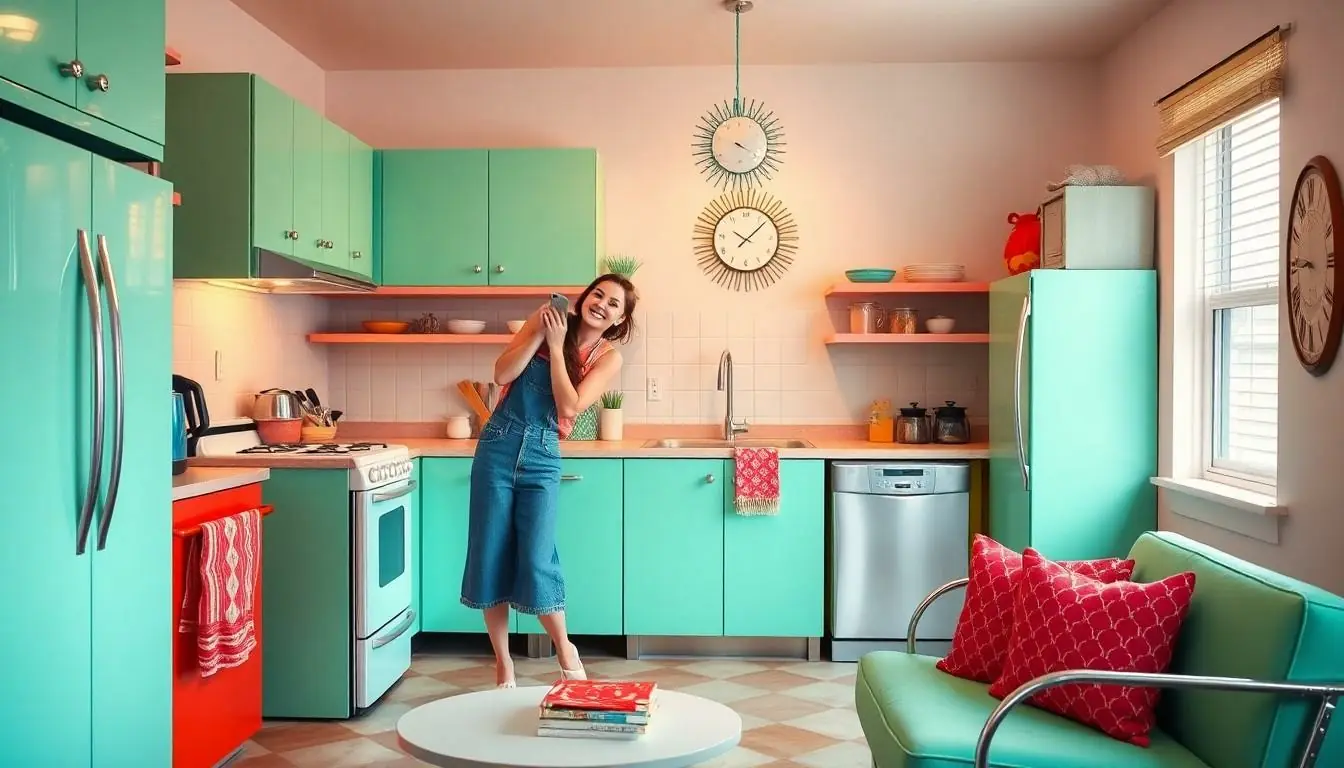Step back in time to the fabulous 1950s, where home decor was as vibrant as a sock hop and as stylish as a poodle skirt. This era transformed living spaces into joyful retreats filled with bold colors, playful patterns, and a touch of kitsch that could make even the grumpiest neighbor crack a smile. From the iconic pastel appliances to the cheeky diner-inspired furniture, 1950s decor wasn’t just about aesthetics; it was a celebration of optimism and post-war prosperity.
Imagine sipping a milkshake at a retro kitchen table while surrounded by atomic age designs. The charm of this decade isn’t just nostalgia; it’s a treasure trove of inspiration for modern homes. Whether you’re a vintage enthusiast or just looking to add a splash of fun to your space, the 1950s offer timeless ideas that’ll make your home the talk of the town—or at least the envy of your friends.
Table of Contents
ToggleOverview of 1950s Home Decor
1950s home decor embraced color and creativity, reflecting the era’s optimism and prosperity. Bright pastels dominated, with mint green, peach, and butter yellow prominent in kitchen appliances and walls. Patterns played a significant role, featuring bold and playful designs such as polka dots, checks, and florals.
Furniture from this period showcased unique styles, including open-backed chairs and sleek, low-profile couches. Icons like the Eames Lounge Chair became symbols of modern design. Dining sets often featured chrome accents and Formica tabletops, evocative of diner culture.
The emphasis on functional decor marked this decade. Multi-purpose furniture became popular, catering to the growing trend of smaller living spaces. Accessories included starburst clocks, lava lamps, and kitschy figurines that added character to homes.
In addition, textiles such as vinyl, cotton, and polyester fabrics added durability and style. Drapery often included bold prints, while kitchen linens showcased fun, whimsical motifs. This diversity allowed homeowners to mix and match styles effortlessly.
Recipient of significant influence from mass media, 1950s decor reflected trends from television shows, magazines, and advertisements. The playful spirit of the decade resonated in every aspect of home design, creating inviting environments.
Overall, the distinct features of 1950s home decor not only marked a departure from traditional styles but also played a vital role in shaping contemporary interior design. Many modern homes draw inspiration from this vibrant period, incorporating retro elements into their aesthetics.
Characteristics of 1950s Home Decor

The 1950s home decor style embraced vivid colors and playful designs, embodying the eclectic spirit of the era. This distinct aesthetic captivated homeowners and designers alike.
Color Palettes
Bright pastels dominated the 1950s color schemes. Popular hues like mint green, peach, and butter yellow adorned kitchen appliances and walls. Contrasting with these light colors, bold accents often emerged in furnishings, creating vibrant living spaces. Combinations of these shades reflected the optimism of the post-war period, inviting cheerfulness into homes. Many kitchens featured colorful cabinetry and countertops, enhancing the overall liveliness.
Furniture Styles
Furniture from the 1950s showcased sleek, modern lines with innovative designs. Open-backed chairs and minimalist couches characterized the style, emphasizing functionality alongside aesthetics. The Eames Lounge Chair exemplified the era’s approach to modern design, balancing comfort and sophistication. Multi-purpose furniture became essential for smaller living areas, catering to practical needs while retaining style. Curved shapes and chrome elements frequently appeared, underscoring the period’s fascination with contemporary trends.
Decorative Accents
Decorative accents added personality and flair to 1950s interiors. Starburst clocks and lava lamps served as iconic symbols of the era, infusing rooms with whimsy and intrigue. Textiles made from vinyl, cotton, and polyester enhanced durability while promoting a lively mix-and-match aesthetic. Accessories often highlighted playful patterns, including polka dots and abstracts, contributing to a joyous environment. Each element played a role in creating a cohesive yet vibrant atmosphere, expressing the eclectic taste of homeowners during this iconic decade.
Popular Trends in the 1950s
Home decor in the 1950s showcased vibrant designs and innovative ideas that captured a sense of optimism. Each trend reflected the era’s spirit, offering unique characteristics.
Mid-Century Modern Influence
Mid-century modern design emerged as a prominent style during the 1950s. Designers emphasized clean lines and organic forms, using materials like molded plastic and plywood. Iconic pieces, such as the Eames Lounge Chair, epitomized functional beauty. Open floor plans encouraged fluid living spaces, fostering interaction among family members. Sculptural accents added visual interest, influencing contemporary decor in today’s homes.
Retro Kitchen Designs
Retro kitchens defined the heart of 1950s homes with their charming aesthetics. Pastel colors like mint green and sunflower yellow adorned appliances and cabinetry. Dinette sets featuring chrome and vinyl brought a diner-like feel to dining spaces. Functionality played a key role, with integrated storage solutions maximizing space. Additionally, whimsical decor items such as colorful salt and pepper shakers enhanced the playful atmosphere.
Vintage Textiles and Patterns
Textiles from the 1950s embraced bold patterns and lively colors. Bright florals, polka dots, and geometric designs covered upholstery and curtains. Cotton and vinyl materials provided durability alongside aesthetic appeal. Homeowners enjoyed mixing patterns and textures, creating unique visual narratives. Vibrant tablecloths often added a cheerful touch, transforming ordinary meals into celebrations.
Iconic Furniture Pieces
The 1950s featured distinctive furniture pieces that defined home decor, blending style with functionality.
Eames Lounge Chair
Eames Lounge Chair remains a symbol of mid-century modern design. Crafted from molded plywood and leather, it showcases a combination of comfort and elegance. Designers Charles and Ray Eames envisioned this chair as a luxurious yet practical seating option. Crafted in 1956, it quickly gained popularity for its lounge-worthy comfort and stylish aesthetics. The chair’s curved silhouette seamlessly fits into any living room, enhancing the overall ambiance. Vintage enthusiasts and contemporary buyers alike appreciate its timeless appeal.
Tulip Table
Tulip Table captures the essence of 1950s innovation in design. Created by Eero Saarinen, this table features a single pedestal base, eliminating the clutter of legs. Its round shape makes it an inviting centerpiece for dining areas. Made from materials such as fiberglass and laminate, it exemplifies the modernist movement’s focus on simplicity. This table’s sleek lines and vibrant colors enhance various decor styles. Homeowners often pair it with matching Tulip chairs, creating a cohesive dining experience. Its iconic stature continues to resonate, ensuring its place in modern spaces.
The vibrant spirit of 1950s home decor continues to inspire modern design. Its playful patterns and bold colors create inviting spaces that celebrate individuality and creativity. By incorporating elements like pastel appliances and iconic furniture pieces, homeowners can effortlessly blend nostalgia with contemporary aesthetics.
This era’s emphasis on functionality and style not only transformed living spaces but also set the stage for future design trends. Whether through retro textiles or sleek lines, the charm of the 1950s remains a timeless influence, encouraging everyone to embrace a joyful and eclectic approach to their homes.





